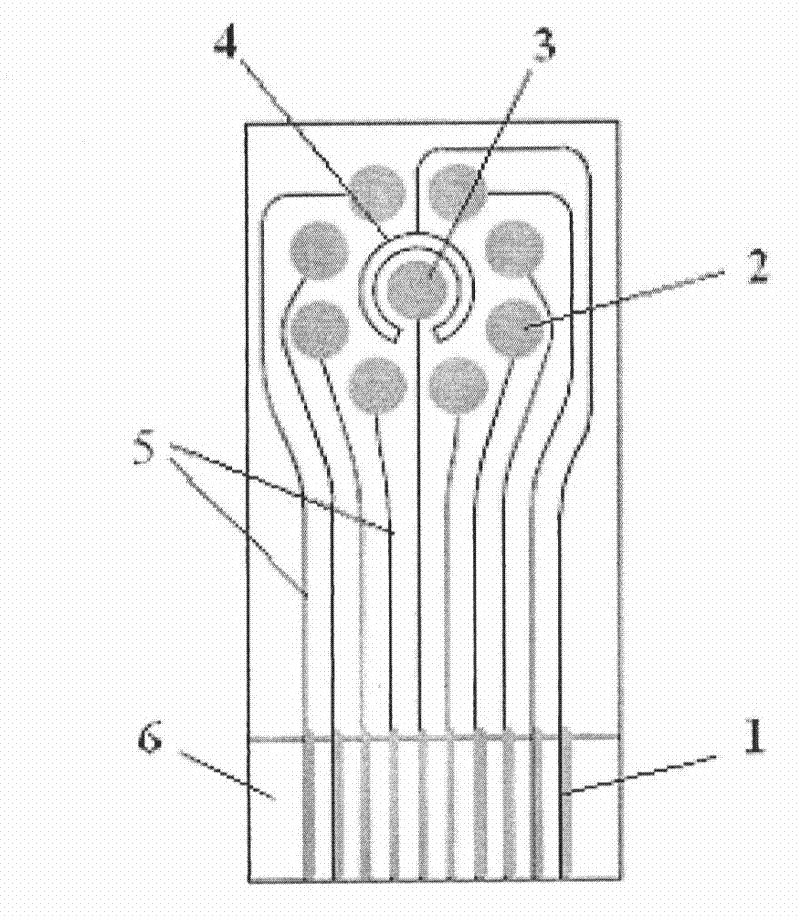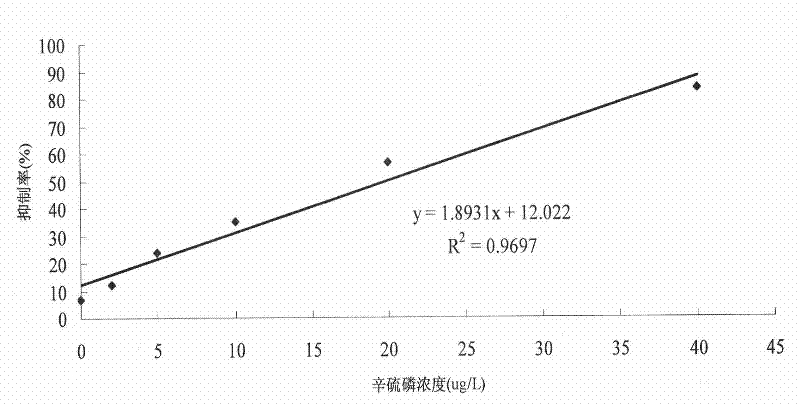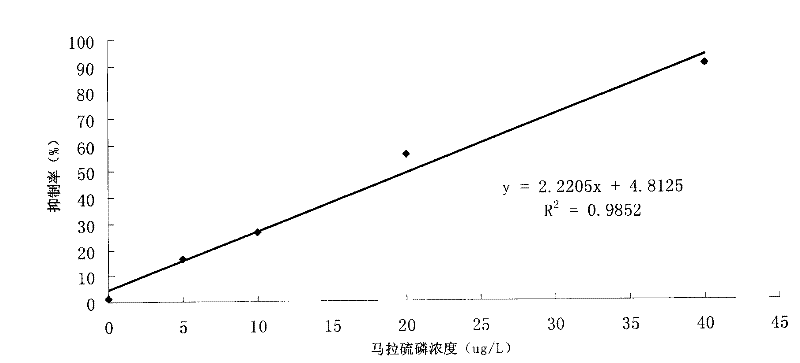Array electrode-based biosensor used for rapidly detecting minimal pesticide residue on fruit and vegetable surfaces
A biosensor and array technology, applied in the field of rapid detection of pesticide residues, can solve the problems of unfavorable instrument miniaturization, reduced instrument sensitivity, and small electrode response current, and achieve reliable detection results, improved detection sensitivity, and increased response current.
- Summary
- Abstract
- Description
- Claims
- Application Information
AI Technical Summary
Problems solved by technology
Method used
Image
Examples
Embodiment 1
[0032] Rapid determination of organophosphorus pesticide residues on apple surface by array electrode biosensor
[0033] 1. Preparation of array electrode biosensor
[0034] On the electrode film substrate, first use screen printing technology to print conductive silver paste to form electrode connections and reference electrodes, and then print conductive carbon paste to cover the terminals to form working electrodes and counter electrodes. The connecting terminal, working electrode, counter electrode and reference electrode are bare conductive materials, and a layer of insulating ink is printed on the rest of the bare parts. Made of insulating film, 8 working electrodes are printed on it with conductive materials, a ring-shaped reference electrode in the center and a disc auxiliary counter electrode, except for all working electrodes, counter electrodes, reference electrodes and terminals, the rest Printed insulating ink overlay.
[0035] The resulting screen-printed elect...
Embodiment 2
[0048] Rapid determination of organophosphorus pesticide residues on apple surface by array electrode biosensor
[0049] 1. Preparation of array electrode biosensor
[0050] Using the screen electrode prepared in Example 1 as the base electrode:
[0051] (1) Disperse carbon nanotubes, glutaraldehyde and acetylcholinesterase in ethanol so that the concentration is 10 mg / ml, and fix acetylcholinesterase on the surface of the working electrode under the joint action of carbon nanotubes and glutaraldehyde to form Composite layer of carbon nanotubes and acetylcholinesterase;
[0052] (2) coating one deck of milky acrylic resin on the surface of above-mentioned composite layer, dry in the shade;
[0053] (3) Use a small volume of 0.05-0.1M phosphate buffer solution (pH 7.0) to drop on the surface of the acrylic resin to form a film of the buffer solution required for the electrochemical reaction on the biosensor.
[0054] 2. Determination of malathion on apple surface with array ...
Embodiment 3
[0063] Rapid Determination of Carbamate Pesticide Residues on Vegetable Leaf Surface with Array Electrode Biosensor
[0064] 1. Preparation of array electrode biosensor
[0065] Using the screen electrode prepared in Example 1 as the base electrode:
[0066] (1) 5 μl of carbon nanomaterials with a concentration of 1 mg / mL (using ethanol as a dispersant) was drip-coated on multiple array working electrodes, and dried under an infrared lamp;
[0067] (2) Apply 5 μl of butyrylcholinesterase solution (dissolved in PBS buffer) with a concentration of 2 U / ml on the electrochemical catalyst layer, add 5 μl of 1% glutaraldehyde solution dropwise, and dry;
[0068] (3) Use a microvolume (40μl) of 0.1M phosphate buffer solution (pH7.0) and an appropriate amount of alkylbenzenesulfonate (surfactant) to form a liquid, adsorb on the PE polymer material, and place it on the biosensor Forms buffer films required for electrochemical reactions.
[0069] The above-mentioned electrode is bent...
PUM
| Property | Measurement | Unit |
|---|---|---|
| diameter | aaaaa | aaaaa |
| diameter | aaaaa | aaaaa |
Abstract
Description
Claims
Application Information
 Login to View More
Login to View More - R&D
- Intellectual Property
- Life Sciences
- Materials
- Tech Scout
- Unparalleled Data Quality
- Higher Quality Content
- 60% Fewer Hallucinations
Browse by: Latest US Patents, China's latest patents, Technical Efficacy Thesaurus, Application Domain, Technology Topic, Popular Technical Reports.
© 2025 PatSnap. All rights reserved.Legal|Privacy policy|Modern Slavery Act Transparency Statement|Sitemap|About US| Contact US: help@patsnap.com



